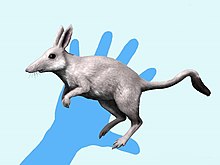Argyrolagus
Appearance
| Argyrolagus | |
|---|---|

| |
| Argyrolagus palmeri | |
| Scientific classification | |
| Domain: | Eukaryota |
| Kingdom: | Animalia |
| Phylum: | Chordata |
| Class: | Mammalia |
| Order: | †Polydolopimorphia |
| Suborder: | †Bonapartheriiformes |
| Family: | †Argyrolagidae |
| Genus: | †Argyrolagus Ameghino 1904 |
| Type species | |
| †Argyrolagus palmeri | |
Argyrolagus is an extinct genus of South American metatherian, belonging to the order Polydolopimorpha from the Early Pliocene Monte Hermoso Formation, Patagonia, Argentina.[1]
Description
Jumping on its hind legs, the 15–20-centimetre (5.9–7.9 in) long (without tail)[2] Argyrolagus resembled a gerbil or kultarr. It had a long tail for balance, and a narrow head with a pointed snout. Judging from its huge eyes, Argyrolagus was nocturnal. The form of its teeth suggest that it would have fed on desert plants.[3] A 2019 study confirmed that Argyrolagus was probably adapted for bipedal jumping and was probably also well adapted for digging.[4]
See also
References
- ^ Argyrolagus at Fossilworks.org
- ^ 新版 絶滅哺乳類図鑑. Yukimitsu Tomida. 30 January 2011.
{{cite book}}: CS1 maint: year (link) - ^ Palmer, D., ed. (1999). The Marshall Illustrated Encyclopedia of Dinosaurs and Prehistoric Animals. London: Marshall Editions. p. 203. ISBN 1-84028-152-9.
- ^ Abello, María Alejandra; Candela, Adriana Magdalena (2020). "Paleobiology of Argyrolagus (Marsupialia, Argyrolagidae): an astonishing case of bipedalism among South American mammals". Journal of Mammalian Evolution. 27: 419–444. doi:10.1007/s10914-019-09470-z.




